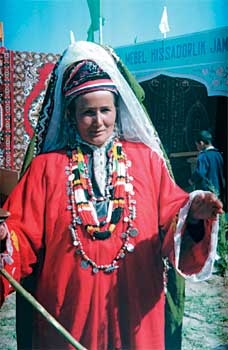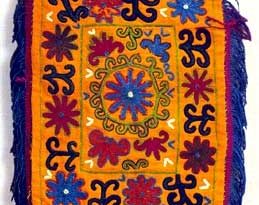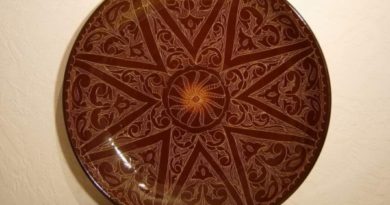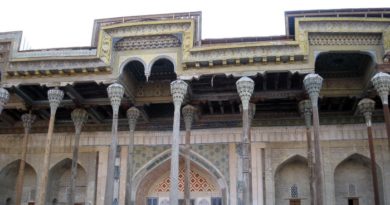Clothing of the Kungrat Women from Surkhandarya
The national costume is one of the brightest expressions of material culture. Age-long traditions and customs of the people, wonderful weaving art and aesthetic priorities typical of each regional culture have found their reflection in it. It is a truism that clothing of inhabitants of different regions of Uzbekistan differed. Clothing of Surkhandarya people, and first of all of the Kungrats, is especially interesting. However, the traditional costume of inhabitants of the Surkhandarya valley has not be studied fully yet.
The ethnic structure in the Surkhandarya valley, located in the southern part of the country, is various. The most numerous and ancient tribe is the Kungrats, a clan coming from Dasht-i-Kipchak, whose clothing, especially female, much differed from clothing of inhabitants of the other regions. Complex of Kungrat female clothing had been forming for centuries under the influence of local conditions, climate and occupations as well as of economic and cultural contacts with neighbouring peoples. The national costume of the Kungrat women includes under-dress and dress, pants (lozim), overclothes, headwear and footwear. In addition, in dependence on their age the women wore various adornments.
At the second half of the XIX c. married women wore the straight dress of traditional fashion, wide with long sleeves. The collar of the dress was decorated in a form of vertical cut of 25 cm in length. Maiden dresses looked like female but differed by their cuts, which were horizontal. Under the influence of the Russian fashion, among the Kungrat women, as among women of the other regions of Uzbekistan, the dresses with upstanding collar became popular. With the passage of time pleated frills decorated its upper part. Now such clothing is used on holidays and for ritual ceremonies. Among pieces of overclothes there is a robe tossed on the head – capote-kurta (zhelak). Kurta reminds chapan, its false long sleeves, receding downward, are turned back, fastened to each other and decorated with the band. Now sleeves and length of kurta are much less in comparison with traditional costume.
Perhaps, the most interesting part of national clothing reflecting original traditional features of the folk costume is the headwear of Kungrat women. It consists of tyubeteika, shawl, kyigich (kulta), “bosh” (ad verbum – a head). The headwear “bosh” is typical only of this region of the republic. It is twisted round like turban and presents a complicated structure consisted of several elements. First, a small cap kyigich (kulta) with over-plait fixture is being put on, and then it is being muffled with 3-5 meters of red or vinous fabric. The Kungrats call it puta. The puta, in its own turn, is winded with four-seven bright shawls of 80×80 cm in size, one after another in herringbone order. A big shawl is covering this structure and then the kurta is following. The woman-widow muffled puta with a layer of a white shawl. In our days “bosh” is mainly the headwear of old women.
The Kungrats followed the nomadic lifestyle spending much time in migrations. The “bosh” protected the head of woman from heat, cold and wind. In addition, in pleats of this headwear the women stored small subjects (threads, needles, pins etc.) required. A number of shawls indicated the social status of the woman, who was called boibosh or kambagal bosh. The girls began to wear “bosh” entering the world of adult women. In general, national clothing of the Kungrat women is very original and various in its aesthetic forms. Such traditional folk applied arts as embroidery, weaving and jewelry art have found their reflection in it. Women decorated their clothes with various beads, buttons and tassels with fringe. Depending on the social status and financial potential of the family, female clothing was sewed from different fabrics: sheeting, chintz, alacha, djanda, silk, adrasa, bekasama, benaresa, velure etc. The most spread in the valley were local fabrics “alacha” and “djanda” of homework.
Choosing the fabric, the Kungrat women preferred red, pink, vinous and whity-pink colours. Women of middle-age and girls sewed their dresses from very bright gladioulus. Blue and black colours were rejected by superstition. The fabrics chosen were striped, sole-coloured and with large pattern. Embroidery occupied the important place in clothing. The Kungrat embroidery differs from the other regions by its colour palette, technique of making and ornament. Embroiderers used mainly geometric and zoomorphic motifs. Switch of the Kungrats to sedentary lifestyle and mergence of their culture with culture of local peoples gave birth to vegetative motifs (islimi) in the Kungrat embroidery. In details (collar, sleeve, edge of dress etc) the pattern was not casual. In addition to aesthetic role the embroidery had a magic function as well. That’s why clothing of the bride and children was decorated with embroidery and embroidered band (cheroz). Earlier the band was embroidered by means of crochet hook from silk threads. Unfortunately, now these traditions are being lost and substituted by bands, not always of good quality, brought from different places, and hand-making embroidery is superseded by machine-stitches.
It is impossible to fancy clothing of the Kungrat women without adornments. Jewelry of the Kungrats like clothing reflects their ethnic originality. Adornments were made mainly of silver, fine beads, cornelian, coral and pearls. Women from rich families preferred gold. On holidays brides and young women wore the frontal sinsilya (silsila), which is also spread among the Kazakhs, Kyrgyzs and Turkmens. One of original adornments that are typical only of this region is the pectoral khalamat, which was made from fine polychromatic beads. Among the Kungrat pectorals there are also haikal, gulband, tomoklov and urpiya. Often necklaces were put one above another in several tiers. From earrings were popular beshpoya, uch kuzacha and adornment for the nostril – letuvu (letiba).
At the early XX c. within new life conditions national clothing of the Kungrat women experienced transformation. Some elements of clothing of neighbouring peoples and modern clothes came into use. But till the end of the XX c. it has preserved traditional forms coming from ancient times.
Author: Binafsha Nodir




